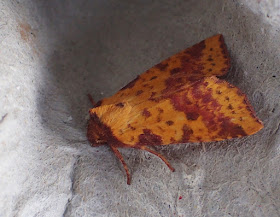On the outside of the trap today a new moth, one I think that may be NFM, certainly NFG, Small Autumnal Moth.
Small Autumnal Moth
A NFY today were two specimens of Haworth's Minor.
Haworth's Minor
Today's triumph (perhaps, it will need confirmation) might be this Trypeta zoe, not listed on the NBN for Orkney, so maybe a first for county. Whatever, a smart wee beast.
Male Trypeta zoe, I think
The trap also contained two Pink-barred Sallow, and the usual suspects.
Pink-barred Sallow
We went over to Deerness and managed to dip on both the pod of Risso's Dolphin and the four Pec Sands (being too lazy to walk over to the pool). At home though a nice male Hen Harrier showed from the kitchen, much to the delight of our visitors, and there were four Ruff in the fields below the house. Later there were three Ruff at Marwick and Hen Harriers, a Shortie, a Greenshank and Water Rails at The Loons.
Hen Harrier
Deerness produced many hoverflies, the Rosa rugosa at Denwick being covered in a species that I am yet to identify. There was an Eristalis intricaria as well as more common things.
Common Carder I think
Although this one looks like Moss Carder, I think it is actually Bombus pasquorum, there are a few black hairs on the abdomen.
Scathophaga stercoraria, common as muck but attractive none-the-less.











No comments:
Post a Comment